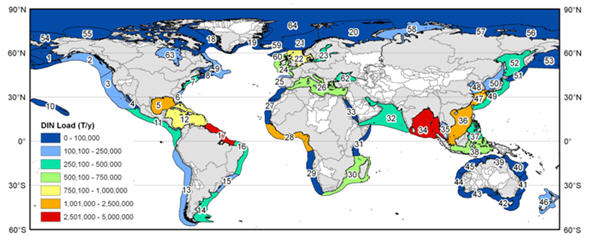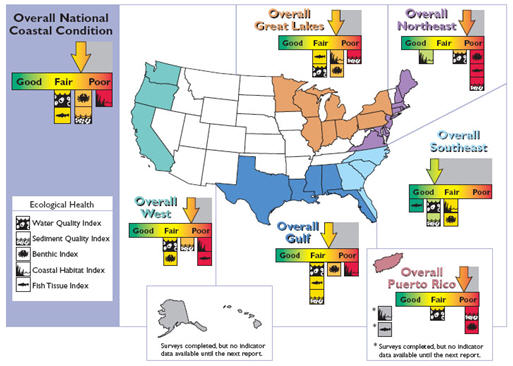POLLUTION AND ECOSYSTEM HEALTH INDICATORS
In several LMEs, pollution and eutrophication have been important driving forces of change in biomass yields. Assessing the changing status of pollution and health of an entire LME is scientifically challenging. Ecosystem health is a concept of wide interest for which a single precise scientific definition is difficult. The health paradigm is based on multiple-state comparisons of ecosystem resilience and stability, and is an evolving concept. To be healthy and sustainable, an ecosystem must maintain its metabolic activity level and its internal structure and organization, and must resist external stress over time and space scales relevant to the ecosystem (Costanza 1992).
The pollution and ecosystem health module measures pollution effects on the ecosystem through the monitoring strategy of the U.S. Environmental Protection Agency. Other pollution indicators include its pathobiological examination of fish and fish tissue, estuarine and nearshore monitoring of contaminants and contaminant effects in the water column, substrate, and selected groups of organisms. Where possible, bioaccumulation and trophic transfer of contaminants are assessed, and critical life history stages and selected food web organisms are examined for indicators of exposure to, and effects from, contaminants. Effects of impaired reproductive capacity, organ disease, and impaired growth from contaminants are measured. Assessments are made of contaminant impacts at both species and population levels. Implementation of protocols to assess the frequency and effect of harmful algal blooms, emergent diseases (Epstein 1993), and multiple marine ecological disturbances (Sherman 2000; Sherman 2001; Sherman and Epstein 2001) are included in the pollution module. A summary of nitrogen and phosphate overenrichment values for the world's 64 LMEs is given in Seitzinger and Lee (2008), (Figure 1).

Figure 1. DIN inputs to LMEs from land-based sources predicted by the NEWS DIN model. Watersheds discharging to LMEs are grey; watersheds with zero coastal discharge are white. Units: Tons N/y. (Figure from Lee and Seitzinger 2008).
In the United States, the EPA has developed a suite of five coastal condition indices -- water quality, sediment quality, benthic communities, coastal habitat, and fish tissue contaminants -- as part of an ongoing collaborative effort with NOAA, the U.S. Fish and Wildlife Service, the U.S. Geological Survey, and other agencies representing states and tribes (Figure 2). The 2004 report, "National Coastal Condition Report II," includes results from EPA's analyses of coastal condition indicators and NOAA's fish stock assessments by LMEs aligned with EPA's national coastal assessment regions (USEPA 2001; USEPA 2004).

Figure 2. Indicators from US EPA's (USEPA 2004) National Coastal Condition Report.
References
Costanza R. 1992. Toward an operational definition of ecosystem health. In: Costanza R, Norton BG, Haskell BD, editors. Ecosystem health: New goals for environmental management. Washington, DC: Island Press. p 239-256.
Epstein PR. 1993. Algal blooms and public health. World Resource Review 5(2):190-206.
Seitzinger S, Sherman K, Lee R. 2008. Filling Gaps in LME Nitrogen Loadings Forecast for 64 LMEs, Intergovernmental Oceanographic Commission Technical Series 79. Paris, France: UNESCO.
Sherman B. 2000. Marine ecosystem health as an expression of morbidity, mortality, and disease events. Marine Pollution Bulletin 41(1-6):232-54.
Sherman BH. 2001. Assessment of multiple marine ecological disturbances: Applying the North American prototype to the Baltic Sea Ecosystem. Human and Ecological Risk Assessment 7(5):1519-1540.
Sherman BH, Epstein PR. 2001. Past anomalies as a diagnostic tool for evaluating multiple marine ecological disturbance events. Human and Ecological Risk Assessment 7(5):1493-1517.
USEPA. 2001. National Coastal Condition Report. Washington, DC: United States Environmental Protection Agency. 204 p.
USEPA. 2004. National Coastal Condition Report. Washington, DC: United States Environmental Protection Agency. 286 p.
Selected Pollution and Ecosystem Health Indicators Module Publications
Multiple Marine Ecological Disturbances (MMEDS)
Epstein PR. 1993. Algal blooms and public health. World Resource Review 5(2):190-206.
Harvell, C. Drew, Mitchell, C.E., Ward, J.R., Altizer, S., Dobson, A.P., Ostfeld, R.S., Samuel, M.D. 2002. Climate warming and disease risks for terrestrial and marine biota. Science 296:2158.
Sherman B. 2000. Marine ecosystem health as an expression of morbidity, mortality, and disease events. Marine Pollution Bulletin 41(1-6):232-54.
Sherman, B. 2001. Asssessment of multiple marine ecological disturbances: Applying the North American prototype to the Baltic Sea Ecosystem. Human and Ecological Risk Assessment 7(5): 1519-1540.
Sherman B. and PR Epstein. Past anomalies as a diagnostic tool for evaluating multiple marine ecological disturbance events Human and Ecological Risk Assessment 7(5): 1493-1517.
Nutrient Overenrichment
Seitzinger S, Sherman K, Lee R. 2008. Filling Gaps in LME Nitrogen Loadings Forecast for 64 LMEs, Intergovernmental Oceanographic Commission Technical Series 79. Paris, France: UNESCO.
Seitzinger, S., Lee, R. 2008. Land-based sources of nutrients to large marine ecosystems. 81-98 in Sherman, K. and Hempel, G. (Editors). 2008. The UNEP Large Marine Ecosystem Report: A perspective on changing conditions in LMEs of the world's Regional Seas. UNEP Regional Seas Report and Studies No. 182. United Nations Environment Programme. Nairobi, Kenya
Ukwe, C.N., Ibe, C.A., Alo, B.I., Yumkella, K.K. 2003. Achieving a paradigm shift in environmental and living resources management in the Gulf of Guinea: The large marine ecosystem approach. Marine Pollution Bulletin 47:219-225.
